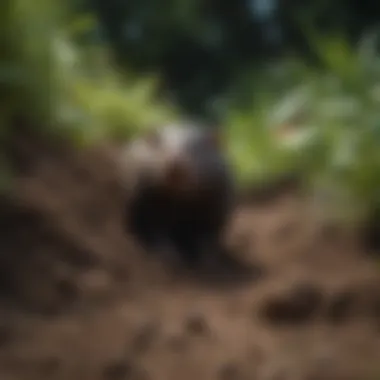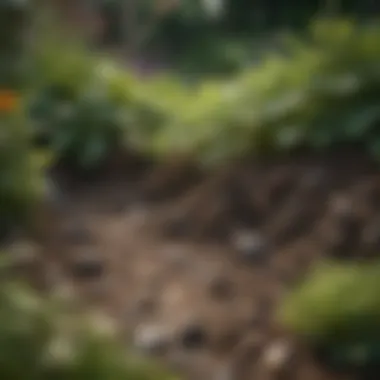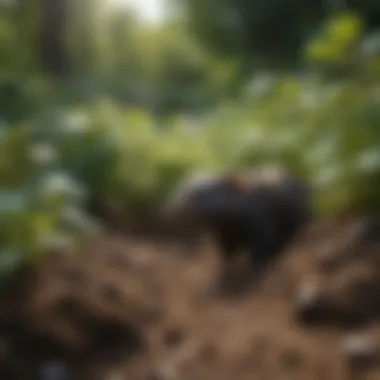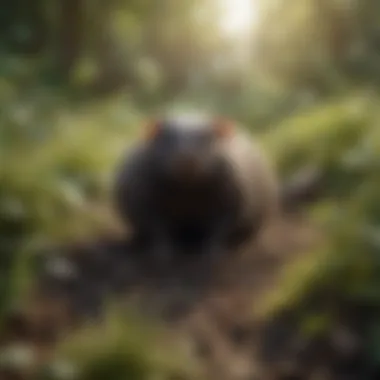Understanding and Managing Moles in Your Garden


Intro
Moles often stir mixed feelings in the minds of gardeners. While some view these small creatures as nuisances causing mayhem beneath the soil, others appreciate their role in the garden's ecosystem. This article digs deeper, aiming to unravel the complexities surrounding moles in garden spaces by offering insights and strategies that fit well within the framework of sustainable gardening.
Understanding the dual nature of moles is essential. On one hand, they aerate the soil, which can enhance its health; on the other hand, their tunneling can damage plant roots and disrupt the visual harmony of a well-maintained garden. With that in mind, we will explore the behavior of moles, the impacts they can have, and actionable approaches for managing their presence.
We'll first delve into some design inspirations pertinent to garden layouts affected by moles. Knowing how to adapt one's design can significantly help in mitigating potential damage. Following that, we will discuss maintenance strategies to manage not only moles but also the overall garden health.
By the end of this article, homeowners and gardening enthusiasts will gain clearer insights into managing moles effectively while maintaining a vibrant and flourishing garden.
Intro to Moles
Understanding moles is crucial for gardeners and nature lovers alike. These small, often misunderstood creatures play complex roles in our ecosystem. Though they can sometimes wreak havoc in well-tended gardens, taking the time to learn about their habits and contributions can provide insight into managing their presence effectively.
Their tunneling activities aerate the soil, promoting healthier ecosystems, and they feast on insects and pests that could cause damage to your plants. Recognizing the key aspects of mole behavior not only helps in mitigating the negative impacts but also positions gardeners to adopt a more holistic approach toward their gardens.
Understanding Moles
Moles are fascinating little mammals, often characterized by their cylindrical bodies, powerful forelimbs, and velvety fur. Interestingly, moles are almost completely adapted to a subterranean life in the soil, which makes it all the more crucial to understand them when they invade our gardens.
Typically, they measure about 6 to 8 inches long and vary in color from gray to brown. Eyesight isn’t one of their strong suits; moles tend to rely on their acute sense of touch and smell to navigate below ground. Their remarkable digging prowess is aided by a special adaptation in their forelegs, which helps them push through soil with ease. With their strong claws, they can create extensive tunnel systems quite rapidly.
These beasts are usually solitary animals, preferring to occupy and defend their territory. This could be up to 200 feet in length, and their tunnels often appear as raised ridges of soil on the surface. Their presence signals a rich habitat possibly flourishing with grubs and earthworms, both beloved snacks!
The Role of Moles in Ecosystems
While many view moles as nuisances, their role in local ecosystems deserves a second look. Moles are essential players in soil health: their tunneling behavior allows oxygen and rainwater to permeate the earth effectively, enhancing its structure. This aeration fosters a healthy environment for roots to grow, enabling numerous plants to thrive.
Moreover, moles are significant predators of pests. By devouring insects, grubs, and even small rodents, they help maintain a natural balance in the garden. This contributes to the overall vitality of your gardening ecosystem, as healthier soil equates to healthier plants.
The irony is that while gardeners often strive for perfect aesthetics, many might overlook the hidden benefits provided by these little diggers. Recognizing their ecological importance can shift perspectives and serve as a reminder that nature often operates on principles that go beyond mere upkeeping of appearances.
Identifying Moles
In a world where gardening enthusiasts put their heart and soul into cultivating lush greens and vibrant blooms, identifying moles is a crucial skill. Understanding these creatures—who they are, their behaviors, and the marks they leave behind—can mean the difference between a thriving garden and one overshadowed by unwanted disruption. Knowing how to identify moles allows homeowners to not only address potential issues proactively but also appreciate the ecological role these animals play in the garden.
Physical Characteristics of Moles
To discover whether a garden is home to moles, it helps to familiarize oneself with their physical traits. Moles are small mammals with distinctive features that set them apart. Typically, they have a cylindrical body that ranges between 6 to 8 inches in length, covered with dense, velvety fur that can be a range of colors from grayish to black. Their most noticeable characteristics include their short legs and large, spade-like hands, which they use effectively to dig tunnels in search of food.
Moles possess a pointed snout, and their eyes are often hidden beneath their fur, making them more suited to life underground. This physical design aids greatly in their burrowing lifestyle, allowing them to navigate through soil with relative ease.
Their unique anatomy combines nature’s engineering—perfect for life beneath the surface.
What many don’t realize is that there are different species of moles—like the Eastern Mole or the Star-nosed Mole—each with subtle differences in size or coloration. Understanding these details can assist gardeners in accurately identifying which species might be operating in their yard, helping to facilitate tailored management strategies.


Signs of Mole Activity in Gardens
Identifying moles is not just a matter of spotting the creatures themselves; attune your eyes to their activities. Gardeners should be on the lookout for several key signs of mole presence:
- Molehills: These are one of the most recognizable indicators. Moles push soil to the surface, creating small, cone-shaped piles. This could be seen scattered throughout the garden, often in straight lines, indicating tunneling activity.
- Tunnels: A telltale sign of moles, tunnels are typically found just under the surface. You might notice raised ridges in the lawn or garden beds. If you press down on these areas, you may feel the tunnel system beneath—a sure sign moles are working hard.
- Disrupted Plants: If plants appear to be wilting or uprooted, it may not simply be due to lack of water or pests. Moles can damage plant roots as they dig, leading to detrimental effects on your blooms and greens.
Uncovering these signs in your garden will help you form an understanding of how extensively moles are operating in your space. This knowledge is essential not only to manage the situation effectively but also to consider approaches to encourage a healthy ecosystem.
Following these identifying practices lays down the groundwork for effective management and potential coexistence with these fascinating, albeit sometimes pesky, creatures.
Mole Behavior and Habits
Understanding the behaviors and habits of moles is crucial for gardeners who wish to develop effective management strategies. Moles are often seen as pests, but they play a significant role in maintaining soil health through their tunneling activities. By recognizing their behavior, we can better appreciate their presence and mitigate the potential damage they might inflict on our gardens. This knowledge can help gardeners maintain a balance between protecting their plants and allowing the ecosystem to thrive.
Mole Diet and Feeding Habits
Moles primarily feed on a diet rich in invertebrates, particularly earthworms, grubs, and insect larvae. They have a remarkable keen sense of smell, allowing them to detect prey underground. One fascinating aspect of their feeding habits is that they eat more than their own body weight in food each day. This high intake is essential for their survival, as they have a fast metabolism and expend a lot of energy digging and moving around their territory.
Moles typically hunt by creating a network of tunnels. These tunnels serve as both a pathway and a way to trap unsuspecting prey. Interestingly, moles have a specialized hunting technique where they pause frequently, using their sensitive snouts to detect movements in the soil. When prey is sensed nearby, they can spring into action, capturing their meal with astonishing speed.
Moreover, the impact of moles on gardens can also be partly attributed to their diet. While they aerate the soil through their tunneling, they might accidentally disturb plant roots, causing stress to ornamental or vegetable gardens. Hence, understanding their feeding habits helps gardeners anticipate potential problem areas and adjust their management strategies accordingly.
Mating and Social Structures
Moles are mostly solitary creatures. The mating season occurs in spring, where male moles will venture outside their tunnels to find a mate. Interestingly, males have been observed to travel great distances during this time. After mating, the female creates a nursery burrow to raise her young. A litter usually consists of three to six pups, which are born blind and hairless.
Once the young moles emerge from their nursery after a few weeks, they are initially dependent on their mother. This dependency, however, doesn’t last long, as they will soon begin to establish their own territories. Adult moles tend to be territorial and will mark their domains, sometimes leading to conflicts with others.
It’s worth noting that while moles are often perceived as pests, their social structure and reproductive habits are quite fascinating. They engage in seasonal lifestyles that ensure the survival of their species and contribute to the underground ecological balance. Understanding these aspects can help gardeners respect their role and find ways to coexist with moles effectively.
"Moles are not merely nuisances; they are a part of the ecosystem that supports healthy soil life. Recognizing their behaviors allows gardeners to manage their presence more wisely."
In summary, a deeper understanding of mole behavior and habits reveals their ecological importance. By acknowledging their dietary preferences and social structures, gardeners can create a more informed and strategic approach to managing their gardens.
Impact of Moles on Gardens
Understanding the impact moles have on gardens is crucial for homeowners and gardening enthusiasts alike. This section explores the various ways moles can alter the garden ecosystem, providing insight into both the potential negatives and some surprising positives. Realizing the dual role moles play can help gardeners make informed decisions about their management strategies.
How Moles Affect Soil Health
Moles are often seen as destructive, but they perform significant functions, especially in soil health. Their tunneling behavior can aerate soil, helping it maintain good structure. This aeration allows water to penetrate deeper, promoting root growth among garden plants. Plus, by breaking up compacted layers of soil, moles enhance nutrient movement and availability.
However, the flip side is that excessive tunneling can disrupt plant roots, particularly those of delicate flowers. When moles dig, they create a network that changes water flow and can lead to erosion in areas with soft soil. For instance, in a vegetable garden, this disruption could spell trouble for crops by causing uneven water distribution which can be especially problematic during dry spells.
Potential Damage to Plant Roots
A gardener’s worst nightmare is dealing with damaged plant roots, and moles can unintentionally be a part of that scenario. As they burrow beneath the surface, moles may disturb or sever the roots of young or shallow-rooted plants. This could stunt growth, making it difficult for plants to absorb water and nutrients adequately.


Here are some common scenarios where moles might affect plant roots:
- Perennials: These can be uprooted, leading to broken root systems and eventually wilting.
- Vegetables: Root vegetables like carrots or radishes suffer the impact of tunneling, which can result in misshapen growth.
- New Plantings: Recently planted shrubs and flowers are at risk when moles decide to tunnel beneath them, as their roots might not yet be firmly established.
Effects on Garden Aesthetics
While moles contribute to a healthy ecosystem, their presence often leads to unsightly mounds of fresh soil that can disrupt the overall aesthetics of a garden. Gardeners invest time and effort into maintaining a pristine look, but moles can create unsightly molehills that detract from a carefully planned landscape.
These mounds can vary in size, but they all share a common effect:
- They may appear on lawns, causing uneven surfaces that can be bothersome when mowing.
- In flower beds, these mounds can smother delicate plants, leading to unsightly patches in the garden layout.
- The overall impression of chaos created by mole activity might even deter visitors or prospective buyers for those looking to sell their homes.
While many consider moles more nuisance than ally, understanding their impact across different facets of the garden can transform one’s approach to mole management. By balancing the negatives with the potential benefits, gardeners can develop a strategy that promotes both healthy soil and a visually appealing garden space.
"Moles can be a gardener's adversary or an unexpected ally. The key is finding the right balance."
Managing Moles in Your Garden
Managing moles in your garden is a vital topic for anyone who wants their gardening efforts to yield the best results. These small, burrowing mammals can cause a surprising amount of damage if their presence is not properly managed. While it might be tempting to see moles purely as pests, they play a role in soil aeration and the ecosystem. The key lies in finding a balance where both your garden and the moles can coexist, benefiting from each other's presence.
The consequences of not addressing mole activity can lead to complications such as damage to plant roots and compromised soil health. Therefore, knowing preventive measures and humane removal strategies is essential for maintaining the integrity of your garden.
Preventative Measures
Maintaining a mole-free garden often starts with implementing preventative measures to deter these critters before they establish themselves in the first place.
Careful Garden Planning
Careful garden planning fundamentally sets the stage for successfully managing mole activity. Taking into account the layout of your garden, the types of plants you are growing, and the overall design can make a difference in how attractive your garden is to moles. For instance, you might consider positioning plants that moles dislike, such as lavender or marigolds, as a natural deterrent.
One key characteristic of this approach is its proactive nature—by employing thoughtful design and choice of flora, you can keep moles at bay. This method is often favored because it avoids chemical interventions, aligning it more closely with sustainable gardening practices. However, one notable disadvantage is that this approach requires some forethought and change to current gardening habits, which some may find challenging.
Creating Barriers
Creating barriers is another effective technique for managing moles. This involves installing underground fences made of hardware cloth, wire mesh, or similar materials, positioned about 12 to 18 inches deep. By doing so, you can prevent moles from entering specific areas of your garden or vegetable patch.
The main strength of utilizing barriers lies in their reliability—once set up correctly, they provide a long-term solution to deter moles. Many gardeners find this method appealing because it is a tangible measure that keeps moles physically out. However, this approach can also be labor-intensive and might require monitoring to ensure no breaches occur over time.
Humane Removal Strategies
When preventative measures fail, moving towards humane removal strategies is the next logical step. These methods aim to shift moles away from the garden without causing them harm.
Live Trapping Techniques
Live trapping techniques involve setting traps designed to capture moles without injuring them. These traps should be placed in active tunnels, identified typically by raised soil mounds or fresh digging. It is critical to check traps regularly to reduce the stress experienced by the captured moles.


A significant advantage of this technique is its ethical foundation—by opting for live traps, gardeners take a compassionate approach while still protecting their gardening space. However, this strategy requires a level of vigilance and commitment, as it is essential to know what to do with the moles once they’re captured—simply relocating them to an unknown area poses risks to their survival.
Natural Repellents
Natural repellents offer an alternative for those looking to deter moles without direct confrontation. Options include planting certain herbs with strong scents or applying substances that irritate moles’ sensory perception. Some common natural options include castor oil or certain essential oils.
The beauty of using natural repellents is their low environmental impact; they align well with organic gardening principles. However, the variety in effectiveness may depend on local conditions, meaning some gardeners might find only marginal success with this approach.
When to Consider Professional Help
In some cases, despite your best efforts, a mole problem can escalate beyond what DIY strategies can handle. If you find yourself overwhelmed or your garden suffering significant damage, it might be time to consider professional help. Pest control services can provide expert insight and interventions that are both humane and effective, ensuring your garden remains healthy and beautiful.
Coexisting with Moles
In the complex web of garden ecosystems, moles often find themselves at the center of contention. While some gardeners perceive them as pests due to their tunneling antics, there’s an equally compelling argument to be made for their valuable role. Understanding how to coexist with moles not only aids in protecting the delicate balance of your garden but also allows for the harnessing of the unexpected benefits they offer.
Understanding the Benefits of Moles
Moles contribute significantly to soil health and garden vitality. These little diggers are not just burrowing nuisances; they aerate the soil, which helps improve drainage and encourages root growth. They work tirelessly below the surface, breaking up compacted earth that can stifle plant development. Their tunneling activities can increase the soil's ability to retain moisture, assisting in drought conditions.
Here are some key benefits of having moles in your garden:
- Natural Pest Control: Moles primarily feed on earthworms and various insects. By managing these populations, they provide a form of natural pest control.
- Soil Enrichment: As moles tunnel, they bring nutrients from deeper layers of soil closer to the surface. This natural fertilizer benefits your plant life in myriad ways.
- Enhanced Soil Structure: The network of tunnels created by moles can help with water infiltration. This results in a more robust ecosystem where plants can access the nutrients they need more effectively.
"Enriching the soil by simply doing their job, moles may be the silent allies every gardener didn’t know they had."
Creating a Balanced Ecosystem
To create a truly harmonious garden, it's vital to recognize that every creature, even those we may not initially welcome, has its place in the biosphere. Coexisting with moles means fostering a balanced ecosystem where their presence contributes to the overall health of your garden. Doing so requires understanding how to manage their activities without drastic measures.
Steps to Foster a Balanced Ecosystem:
- Diverse Planting: Encourage a variety of plants that attract insects and earthworms, ensuring that while moles feed, they don’t raze entire patches of your garden.
- Soil Health Management: Regularly add organic matter to your soil. The richer and healthier your soil, the more it draws beneficial organisms, including moles, that help preserve that health.
- Monitor Changes: Keep an eye on plant health and soil conditions. If you notice excessive damage, reassess whether interventions may be needed without resorting to harm.
By recognizing moles as an integral part of the garden community, homeowners can cultivate a thriving environment that flourishes, not just in spite of these creatures but perhaps because of them. It's all about balance and appreciation for the myriad ways that huams and nature can harmoniously interact.
Ending
The conclusion of this article serves as a crucial reflection on the interplay between moles and garden ecology. It emphasizes the need for awareness amongst gardeners about the dual nature of moles; while they can pose challenges in terms of garden aesthetics and certain plant health, they also contribute significantly to soil aeration and pest control.
Reflecting on Garden Ecology
Understanding how moles fit into the broader ecosystem is vital for any gardener. By digging tunnels and creating mounds, moles improve soil structure, which enhances drainage and promotes healthy root systems for plants. Their burrowing habits facilitate the movement of water and nutrients through the soil, which can improve the overall health of your garden.
However, it’s essential to recognize that a balance must be struck. Excessive mole activity can lead to overworked soil and damaged roots, especially for delicate plants. Therefore, gardeners need to regularly assess both the mole population and the health of their gardens, ensuring a cooperative relationship that benefits all.
"Moles, like many creatures, are part of nature’s complex web; neglecting their role can lead to unintended consequences in your gardening endeavors."
Future Considerations for Gardeners
As we move forward, there's a growing emphasis on sustainable gardening practices. This serves to remind us that coexistence with moles is not just possible but beneficial when done correctly. Here are some key considerations for gardeners:
- Adaptation and Observation: Stay observant about how moles influence your garden and adapt management strategies accordingly.
- Planning for Diversity: Plant a diverse range of flora, which can tolerate some disruption without succumbing to damage. This will help in mitigating the impacts of mole activity.
- Engaging with Local Community: Join gardening communities on platforms like Reddit and Facebook to share experiences and gather insights on managing moles while fostering ecosystem health.







